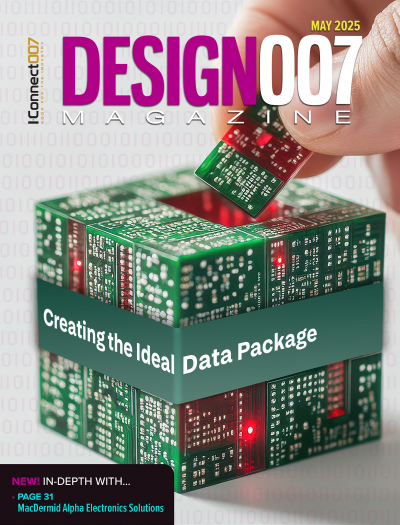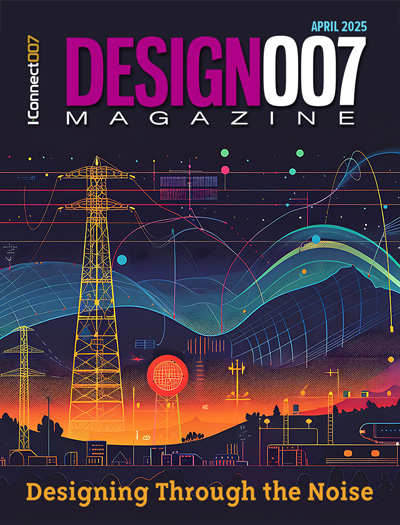-

- News
- Books
Featured Books
- design007 Magazine
Latest Issues
Current Issue
All About That Route
Most designers favor manual routing, but today's interactive autorouters may be changing designers' minds by allowing users more direct control. In this issue, our expert contributors discuss a variety of manual and autorouting strategies.

Creating the Ideal Data Package
Why is it so difficult to create the ideal data package? Many of these simple errors can be alleviated by paying attention to detail—and knowing what issues to look out for. So, this month, our experts weigh in on the best practices for creating the ideal design data package for your design.

Designing Through the Noise
Our experts discuss the constantly evolving world of RF design, including the many tradeoffs, material considerations, and design tips and techniques that designers and design engineers need to know to succeed in this high-frequency realm.
- Articles
- Columns
- Links
- Media kit
||| MENU - design007 Magazine
Keep the Change? No, Embrace It
February 9, 2022 | Tamara Jovanovic, Happiest BabyEstimated reading time: 2 minutes
In a world where technology is so quickly evolving, we really shouldn’t be surprised that companies and professional events have gone virtual. Change can be daunting, but as we all master navigating life in this “new normal” (don’t you hate that term?), we realize that not much of our professional lives has changed. You still have to go to work every day, but now you just do so from the comfort of your home, and you don’t interact with people in person.
Obviously, the global pandemic had a massive impact on work culture. Even though the situation with the virus is slowly improving, a lot of companies are still maintaining a flexible workplace. Thanks to modern technology, a lot of companies were able to continue working seamlessly despite all the hurdles that the pandemic has created.
As employees continue to be efficient at working remotely, many employers don’t see a need for expensive office space anymore. Many employers allow their workers to continue working from home and use the office as needed. I believe that this hybrid work environment is what the future holds for most companies. This change in work dynamic allows people to have more freedom with their personal lives while still getting their jobs done, which promotes a healthy work-life balance.
Of course, human beings are social creatures who depend on each other to thrive and survive. As a hardware engineer, I do lot of hands-on work with the product and prototypes, and this requires me to be in the office most of the time. As part of a team, I often work with other people and depend on my team members for various kinds of tasks. Most of my team also works from the office, and I personally don’t have problems with communication, but I can see a potential for miscommunication. If you’re working remotely, sometimes it can be hard to get in touch with a team member. When you need information from another person to continue your own work and that person is unavailable, this could delay the project you’re working on.
In the PCB design world, a variety of factors dictate the difficulty of the project and how much time is required for the design to be complete. I work closely with the mechanical engineers at my company while working on a design to make sure that what I am doing on the electrical side will not interfere with the mechanical design and constraints. Once the testing and proof of concept is complete and I have a board outline, I can work on schematics and layout on my own until completion, which is when I circle back to the mechanicals to double-check the final design and make any tweaks if necessary. Regardless of what is happening in the outside world, this process for designers in consumer electronics is unlikely to change, because it’s usually a collaborative effort to make all the pieces of the puzzle come together.
To read this entire conversation, which appeared in the February 2022 issue of Design007 Magazine, click here.
Suggested Items
DownStream Acquisition Fits Siemens’ ‘Left-Shift’ Model
06/26/2025 | Andy Shaughnessy, I-Connect007I recently spoke to DownStream Technologies founder Joe Clark about the company’s acquisition by Siemens. We were later joined by A.J. Incorvaia, Siemens’ senior VP of electronic board systems. Joe discussed how he, Rick Almeida, and Ken Tepper launched the company in the months after 9/11 and how the acquisition came about. A.J. provides some background on the acquisition and explains why the companies’ tools are complementary.
Elementary Mr. Watson: Retro Routers vs. Modern Boards—The Silent Struggle on Your Screen
06/26/2025 | John Watson -- Column: Elementary, Mr. WatsonThere's a story about a young woman preparing a holiday ham. Before putting it in the pan, she cuts off the ends. When asked why, she shrugs and says, "That's how my mom always did it." She asks her mother, who gives the same answer. Eventually, the question reaches Grandma, who laughs and says, "Oh, I only cut the ends off because my pan was too small." This story is a powerful analogy for how many PCB designers approach routing today.
Connect the Dots: The Future of PCB Design and Manufacturing
07/02/2025 | Matt Stevenson -- Column: Connect the DotsFor some time, I have been discussing the increasing complexity of PCBs and how designers can address the constantly evolving design requirements associated with them. My book, "The Printed Circuit Designer’s Guide to… Designing for Reality," details best practices for creating manufacturable boards in a modern production environment.
Siemens Turbocharges Semiconductor and PCB Design Portfolio with Generative and Agentic AI
06/24/2025 | SiemensAt the 2025 Design Automation Conference, Siemens Digital Industries Software today unveiled its AI-enhanced toolset for the EDA design flow.
Cadence AI Autorouter May Transform the Landscape
06/19/2025 | Andy Shaughnessy, Design007 MagazinePatrick Davis, product management director with Cadence Design Systems, discusses advancements in autorouting technology, including AI. He emphasizes a holistic approach that enhances placement and power distribution before routing. He points out that younger engineers seem more likely to embrace autorouting, while the veteran designers are still wary of giving up too much control. Will AI help autorouters finally gain industry-wide acceptance?


